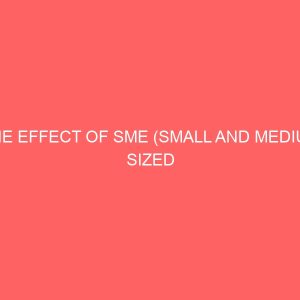Description
ABSTRACT
Small and medium scale enterprises have long believed to be catalysts for economic growth and national development both in developed and developing countries. In Nigeria where private sector is not well developed SME is assumed to play the role of employment generation, facilitator of economic recovery and national development. The paper examined small and medium scale enterprises in Nigeria and in relation to those challenges which affects SMEs from developing capacity to realizing its full potentials as well the prospect for improvement and development for employment generation, economic growth and national development. It is suggested therefore that invigorating SMEs with strengthened commitment to economic reform would offer a turning point in facilitating the recovery of Nigeria economy and national development.
This study is also designed to find out those roles that the SMEs play in alleviating poverty in Nigeria.
CHAPTER ONE
1.0.INTRODUCTION AND BACKGROUND
Since Nigeria attained independence in 1960, considerable efforts have been directed towards industrial development. The initial efforts were government led through the vehicle of large industry, but lately, emphasis has shifted to Small and Medium Scale Enterprises SMEs following the lessons learnt from the success of SMEs in the economic growth of Asian countries Ojo, 2003. Thus, the recent industrial development drive in Nigeria has focused on sustainable development through small business development. Prior to this time, particularly judging from the objectives of the past National Development Plans, 196268, 197075, 197680 and 198185, emphasis had been on government led industrialization, hinged on import substitution strategy.
Since 1986, government had reduced its role as the major driving force of the economy through the process of economic liberalization entrenched in the IMF pill of Structural Adjustment Programme. Emphasis, therefore, has shifted from largescale industries to small and medium scale industries, which have the potentials for developing domestic linkages for rapid and sustainable industrial development. Attention was focused on the organized private sector to spearhead subsequent industrialization programmes. The incentives given to encourage increased participation in these sectors were directed at solving and/or alleviating the problems encountered by industrialists in the country, thereby giving them opportunity to increase their contribution to the Gross Domestic Product GDP.
The contribution of Micro, Small amp; Medium Enterprises MSMEs to economic growth and sustainable development is globally acknowledged CBN, 2004. There is an increasing recognition of its pivotal role in employment generation, income redistribution and wealth creation NISER, 2004. The micro, small and medium enterprises MSMEs represent about 87 per cent of all firms operating in Nigeria USAID, 2005. Nonfarm micro, small and medium enterprises account for over 25 per cent of total employment and 20 percent of the GDP SMEDAN, 2007 compared to the cases of countries like Indonesia, Thailand and India where Micro, Small and Medium Enterprises MSMEs contribute almost 40 percent of the GDP IFC, 2002.
Whilst MSMEs are an important part of the business landscape in any country, they are faced with significant challenges that inhibit their ability to function and contribute optimally to the economic development of many African countries. The position in Nigeria is not different from this generalized position NIPC, 2009.
Realizing the importance of small businesses as the engine of growth in the Nigerian economy, the government took some steps towards addressing the conditions that hinder their growth and survival. However, as argued by Ojo 2003, all these SME assistance programmes have failed to promote the development of SMEs. This was echoed by Yumkella 2003 who observes that all these programmes could not achieve their expected goals due largely to abuses, poor project evaluation and monitoring as well as moral hazards involved in using public funds for the purpose of promoting private sector enterprises. Thus, when compared with other developing countries, Variyam and Kraybill 1994 observed that many programmes for assisting small businesses implemented in many SubSaharan African SSA countries through cooperative services, mutual aid groups, business planning, product and market development, and the adoption of technology, failed to realize sustained growth and development in these small enterprises. Among the reasons given were that the small sized enterprises are quite vulnerable to economic failure arising from problems related to business and managerial skills, access to finance and macroeconomic policy.
Despite MSMEs important contributions to economic growth, small enterprises are plagued by many problems including stagnation and failure in most sub-Saharan African countries Bekele, 2008. In Nigeria, the problem is not limited to lack of long term financing and inadequate management skills and entrepreneurial capacity alone, but also, includes the combined effect of low market access, poor information flow, discriminatory legislation, poor access to land, weak linkage among different segments of the operations in the sector, weak operating capacities in terms of skills, knowledge and attitudes, as well as lack of infrastructure and an unfavorable economic climate.
Lack of access to finance has been identified as one of the major constraints to small business growth Owualah, 1999; Carpenter, 2001; Anyawu, 2003; Lawson, 2007. The reason is that provision of financial services is an important means for mobilizing resources for more productive use Watson and Everett, 1999. The extent to which small enterprises can access fund determines the extent to which small firms can save and accumulate their own capital for further investment Hossain, 1988, but small business enterprises in Nigeria find it difficult to gain access to formal financial institutions such as commercial banks for funds. The inability of the MSEs to meet the conditionality’s of the formal financial institutions for loan consideration provided a platform for attempt by informal institutions to fill the gap usually based on informal social networks; this is what gave birth to micro financing. In many countries, people have relied on the mutually supportive and benefit sharing nature of the social networking of these sectors for the fulfilment of economic, social and cultural needs and the improvement of quality of life Portes, 1998. Networks based on social capital exist in developed as well as developing countries including Nigeria.
The reluctance of formal financial institutions to introduce innovative ways of providing meaningful financial assistance to the MSEs is attributed to lack of competition among financial service providers, in the sense that none of financial service providers came up with an innovative way of financing small businesses. In order to enhance the flow of financial services to the MSME subsector, Government had, in the past, initiated a series of programmes and policies targeted at the MSMEs. Notable among such programmes were the establishment of Industrial Development Centres across the country 196070, the Small Scale Industries Credit Guarantee Scheme SSICS 1971, specialized financial schemes through development financial institutions such as the Nigerian Industrial Development Bank NIDB 1964, Nigerian Bank for Commerce and Industry NBCI 1973, and the National Economic Recovery Fund NERFUND 1989. All of these institutions merged to form the Bank of Industry BOI in 2000. In the same year, Government also merged the Nigeria Agricultural Cooperative Bank NACB, the Peoples Bank of Nigeria PBN and Family Economic Advancement Programme FEAP to form the Nigerian Agricultural Cooperative and Rural Development Bank Limited NACRDB. The Bank was set up to enhance the provision of finance to the agricultural and rural sector. Government also facilitated and guaranteed external finance by the World Bank including the SME I and SME II loan scheme in 1989, and established the National Directorate of Employment NDE in 1986.
In 2003, the Small and Medium Enterprise Development Agency of Nigeria SMEDAN, an umbrella agency to coordinate the development of the SME sector was established. In the same year, the National Credit Guarantee Scheme for SMEs to facilitate its access to credit without stringent collateral requirements was reorganized and the Entrepreneurship Development Programme was revived. In terms of financing, an innovative form of financing that is peculiar to Nigeria came in the form of intervention from the deposit money banks. The deposit money banks through its representatives, the Bankers Committee, at its 246th meeting held on December 21, 1999. The deposit money banks agreed to set aside 10 of their profit before tax PBT annually for equity investment in small and medium scale industries. The scheme aimed, among other things, to assist the establishment of new, viable SMI projects; thereby stimulating economic growth, and development of local technology, promoting indigenous entrepreneurship and generating employment. Timing of investment exit was fixed at minimum of three years, that is, banks shall remain equity partners in the business enterprises for a minimum of three years after which they may exit anytime. By the end of 2001, the amount set aside under the scheme was in excess of six billion naira, which then rose to over N13 billion and N41.4 billion by the end of 2002 and 2005 respectively.
The modality for the implementation of the fund is such that the fund set aside is to be invested within 18 months in the first instance and 12 months thereafter. After the grace period, the CBN is required to debit the banks that fail to invest the fund set aside and invest same in treasury bills for 6 months. Thereafter, the uninvested fund would be bidded for by successful investors under the scheme. The fund set aside by the banks under the scheme decreased from N41.4 billion in 2005 to N38.2billion in 2006. This was as a result of N2.5billion and N25.3 million set aside from failed banks and liquidated banks respectively, which were netted out after the bank consolidation exercise. Actual investment during the period grew from N12 billion in December 2005 to N17 billion in 2006, representing only 29.1 percent of the total fund set aside. In 2007, total amount set aside decreased further to N37.4 billion, while total investment stood at N21.1 billion representing 56 percent of the total sum set aside. The number of projects that benefitted from the scheme also increased to 302 projects in 2007, from 248 in 2006 CBN, 2007.
The CBN found the reasons for the slow pace in utilization of the SMIEIS fund to include: the desire of the Banks to acquire controlling shares in the funded enterprises and the entrepreneurs resistance to submit control; inability of the banks to adapt equity investment which is quite different from what the banks are familiar with in credit appraisal and management, and lack of proper structure for effective administration of the scheme when it took off among other factors. Responding to the findings, the Bankers Committee took a policy decision to extend funding under the scheme to all business activities including even nonindustrial enterprises, except for general commerce and financial services. The name of the scheme was changed from SMIEIS to Small and Medium Enterprises Equity Investment Scheme SMEEIS to reflect the expanded focus. Also, the limit of banks equity investment in a single enterprise was increased from N200 million to N500 million, making room for medium size industries.
Despite all these efforts, the contribution of SMEs in the industrial sector to the Nations GDP was estimated to be 37 compared to other countries like India, Japan and Sri Lanka and Thailand where SMEs contributed 40, 52 55 and 47.5 respectively to the GDP in 2003, UNCTAD, 2003, hence the need for alternative funding window. In 2005, the Federal Government of Nigeria adopted microfinance as the main financing window for micro, small and medium enterprises in Nigeria. The Microfinance Policy Regulatory and Supervisory Framework MPRSF was launched in 2005. The policy, among other things, addresses the problem of lack of access to credit by small business operators who do not have access to regular bank credits. It is also meant to strengthen the weak capacity of such entrepreneurs, and raise the capital base of microfinance institutions. The objective of the microfinance policy is to make financial services accessible to a large segment of the potentially productive Nigerian population, which have had little or no access to financial services and empower them to contribute to economic development of the country.
The microfinance arrangement makes it possible for MSEs to secure credit from Microfinance Banks MFBs and other Microfinance Institutions MFIs on more liberal terms. It is on this platform that we intend to examine the impact of microfinance on small business growth, survival, as well as business performance of MSEs operators.
1.1. OBJECTIVES OF THE STUDY
The aim of this study is to estimate the effects of micro financing on business performance of SMEs in Nigeria.
The primary objectives are to:
1.Assess the contributions of SMEDAN to the survival of SMEs in Nigeria.
2.Analyze the effects of SMEDAN on SME growth and expansion capacity in Nigeria.
3.Ascertain the effects of SMEDAN on the productivity of SMEs operators in Nigeria.
4. Examine the effects of nonfinancial services of microfinance institutions on SMEs business performance in Nigeria.
5.Document the operations and processes of SMEDAN activities in Nigeria.
1.2. SIGNIFICANCE OF THE STUDY
A significant amount of empirical research has been carried out both within and outside the country on the relationship between microfinance and microenterprise development See Kotir and Obegodom, 2009; Ogunrinola and Alege, 2007; Pronyk, Hargreaves and Morduch, 2007; Matouv, 2006; Khandker, 2005; Morduch and Haley, 2002. It has been observed from the literature, that most research works treated microfinance as a solution to poverty. To the best of our knowledge, the impact of microfinance on Small and Medium Enterprise survival and growth has not been empirically tested in the literature, especially in Nigeria. Most researchers in Nigeria have also not taken time to document the nature, mode of operation and processes involved in SMEDAN. This study therefore becomes significant in filling this observed gap by testing empirically the impact of both the financial and nonfinancial services offered by SMEDAN on small business growth/survival and by examining the capability of SMEDAN institutions in enhancing the expansion capacity of small businesses in Nigeria. The study also contributes to the literature on SMEDAN and small business survival.
1.2STATEMENT OF RESEARCH PROBLEMS
Majority of the small and medium enterprises SMEs in Nigeria are still at a low level of development, especially in terms of number of jobs, wealth and value creation. This is because 65 of the active population, who are majorly entrepreneurs, remain unserved by the formal financial institutions. The SMEDAN institutions available in the country prior to 2005 were not able to adequately address the gap in terms of credit, savings and other financial services. As reported by the CBN, the share of micro credit as a percentage of total credit was 0.9, while its contribution to GDP was a mere 0.2 CBN, 2005. The CBN in 2005 identified the unwillingness of conventional banks to support microenterprises, paucity of loanable funds, absence of support institutions in the sector, as well as weak institutional and managerial capacity of existing microfinance institutions among other reasons as the major reasons for the failure of past microfinance initiatives in the country. To address the situation, the Microfinance Policy, Regulatory and Supervisory Framework MPRSF for Nigeria was launched by CBN in 2005 to provide sustainable financial services to micro entrepreneurs. This initiated an important turning point in the microfinance industry with the establishment of the Microfinance Bank MFB as an institutional vehicle for privately owned, deposit taking Microfinance Institutions MFIs. The framework is designed to unite the best of the NGO credit organizations, and new MFI initiatives under a common legal, regulatory and supervisory regime. Five years down the line, though microfinance has proven to be one of the ways of bridging the resource gap created in the Nigerian economy, there are still some undesirable problems experienced against its proper execution. The lack of documentation of the practice of micro financing in Nigeria has made it difficult to formulate supportive programs for the growth of the sector.
1.4. RESEARCH QUESTION
The study attempts to answer the following research questions:
1.To what extent does SMEDAN enhance the survival of SMEs in Nigeria
2.To what extent is the growth of small businesses influenced by the financing capacity of SMEDAN
3.How does the injection of SMEDAN funds into small business operations affect the productivity of SMEs in Nigeria
4.What roles does the incorporation of nonfinancial services of SMEDAN play in enhancing the business performance of SMEs in Nigeria
5.What is the nature, mode of operation and process of SMEDAN in Nigeria
6.How does they create fund to the public
1.5. SCOPE OF THE STUDY
The study provides insight into SMEDAN and small business survival and growth, as well as provides a measure of the effects of SMEDAN on small business performance and productivity in Nigeria. It covers SMEs that have access to SMEDAN for a period of at least five years 2009 2014. The population for the study includes the clients of the selected SMEDAN, that is, the 169 Microfinance Banks in the SouthWest geopolitical zone that have obtained their final operating licenses as of the year 2009.
1.6 LIMITATION OF THE STUDY
The main limitation of the study is the reliance on information supplied by SMEDAN business operators who normally do not want to make a full disclosure of their businesses to an unknown person for fear of being subjected to tax payment. In the same vein, most of the small business operators lack proper record keeping practices and do not adhere to standard book keeping and accounting procedures. Some of them do not have the necessary skills needed for sound book keeping, auditing and tax assessment; neither do they employ qualified personnel to undertake such tasks for them. The oath of secrecy between the bank and its customers is another area of constraint in this study. Factors such as economic environment, political instability and government policy on SMEs are considered to have strong effects on MSE performance but are not readily available and so constitute a constraint to the study. However, we rely on scientific methods to obtain the data and the analysis is based on superior analytical techniques, which we believe allow us to generalize our findings.
Following constitutes the limitation of the project work.
1.FINANCE PROBLEM: There were various sources of data collection and all the sources are sparsely located and the research of each of every one of them requires finance which at the time of this research work was limited.
2.BIASED ATTITUDES FROM RESPONDENTS: Some respondents bluntly refused to give out the required information that i was in need of. Responses from some respondents and my present experience as a student serve as a stepping stone in conjunction with my textbook.
1.7. DEFINITION OF TERMS
I.Small enterprise: Small enterprise is any enterprise that employs between ten 10 to fortynine 49 people and has asset worth excluding land and building between N5 million and N50 million.
II.Medium enterprise: Medium enterprise is any enterprise that employs between fifty 50 and one hundred and ninetynine 199 people and has assets worth excluding land and building between N50 million and N500 million SMEDAN, 2007.








Reviews
There are no reviews yet.